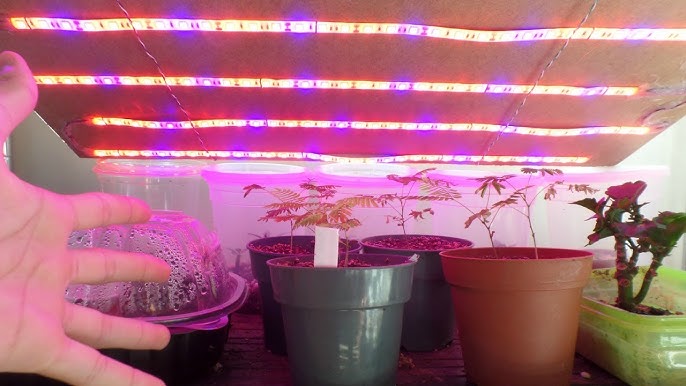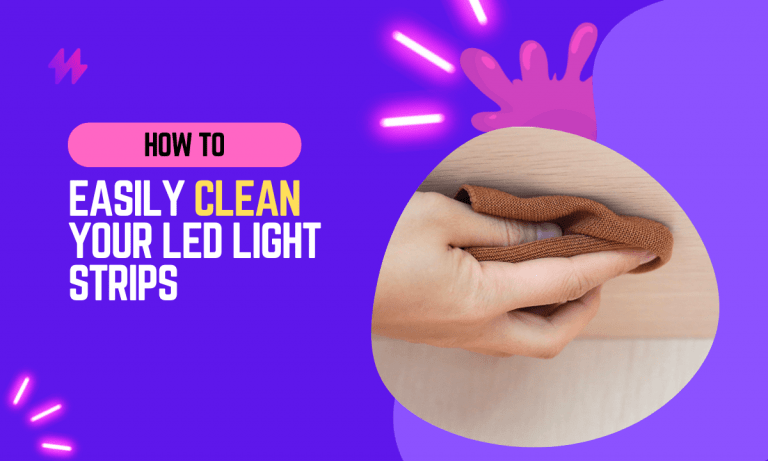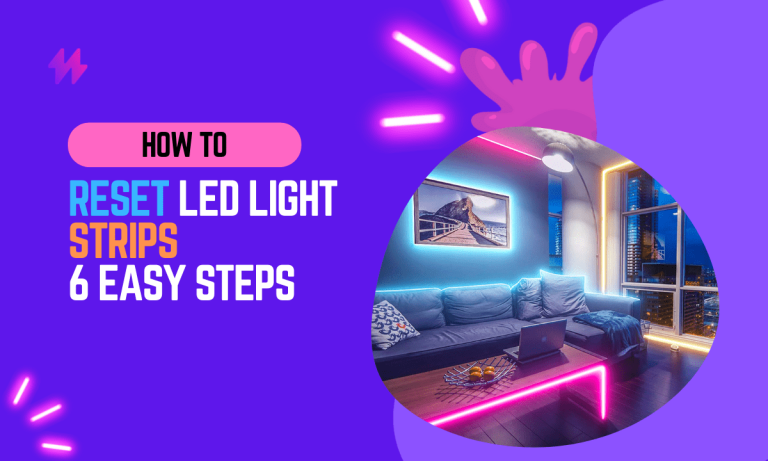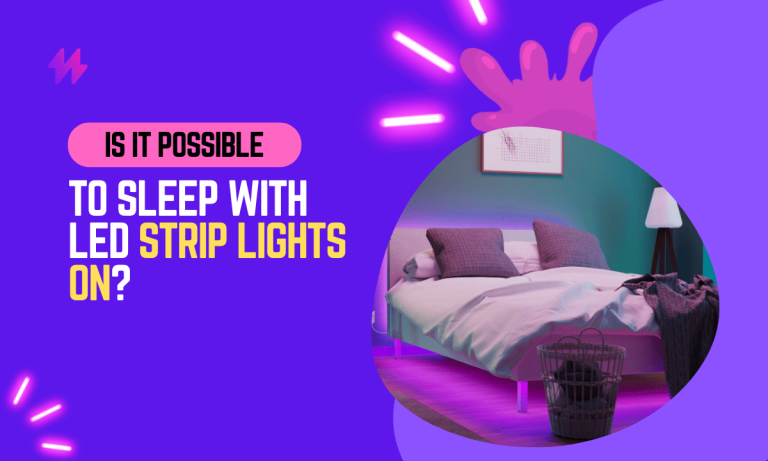Can You Use LED Strips to Grow Plants?

LED strips are a popular choice for lighting, but can they also be used to grow plants? In this article, I’ll explore the question of whether or not LED strips are a viable option for plant growth. I’ll also share my own experience using LED strips to grow plants, as well as some tips and advice on how to get the best results.
LED strips are a great way to add accent lighting to a room, but they’re not typically used for growing plants. This is because most LED strips emit light in the blue and green spectrum, which is not ideal for plant growth. Plants need a balance of red, blue, and green light in order to thrive.
While LED strips may not be the most ideal lighting for all types of plants, they can still provide a supplemental light source for indoor gardens. By using specialized grow bulbs that emit the correct spectrum of light, cultivators can support the plant development of various indoor plants, ensuring successful plant growth and vibrant foliage.
My Journey with LED Strips: Harnessing Their Power to Grow Plants

I’ve been experimenting with using LED strips to grow plants for a few years now. I’ve found that it is possible to grow some plants using LED strips, but it’s not as easy as using a grow light that emits a full spectrum of light.
I’ve had the most success growing leafy greens, such as lettuce and spinach, using LED strips. I’ve also had some success growing herbs, such as basil and mint. However, I’ve had a lot of trouble growing fruiting plants, such as tomatoes and peppers, using LED strips.
If you’re interested in using LED strips to grow plants, I recommend choosing plants that are tolerant of low light levels. Leafy greens and herbs are good options, as are some flowering plants, such as African violets.
LED strips are a popular choice for lighting up homes and businesses, but can they also be used to grow plants? The answer is yes, but there are a few things you need to know before you get started.
Utilizing LED strip lights for indoor gardening presents unique advantages and challenges that growers must navigate. Adequate lighting, along with quality plant growth practices, will ensure thriving plant life, making it essential to understand plant needs and optimal growing environments when using these specialized lights.
Understanding How LED Strips Light Work: A Guide to Growing Plants
LED strips are made up of a series of light-emitting diodes (LEDs) that are connected together in a long strip. Each LED emits light when electricity flows through it, and the color of the light is determined by the type of LED used.
LED strips are typically powered by a low-voltage power supply, and they can be controlled using a dimmer switch or a timer. This makes them a versatile lighting option for a variety of applications.
LED strip lights can be effectively used as grow lights for indoor gardening projects, making them ideal for cultivating both ornamental plants and various vegetables. When combined with proper growing mediums and plant nutrients, these lights can significantly enhance plant health and support successful seed germination and vegetative plant growth.
Exploring the Potential: Can You Use LED Strips to Grow Plants?
Yes, LED strips can be used to grow plants. However, not all LED strips are created equal. Some LED strips are designed for general lighting purposes, while others are specifically designed for plant growth.
Plant growth lights emit a specific spectrum of light that is ideal for plant growth. This spectrum includes red and blue light, which are the two colors that plants need most for photosynthesis.
When choosing LED strips for plant growth, it is important to select a strip that emits the correct spectrum of light. You should also consider the intensity of the light, as too much light can damage plants.
LED strip lights can enhance various aspects of plant biology, especially when tailored for specific plant requirements. Utilizing the right led bulbs can support healthy plant growth, ensuring that both the foliage and roots thrive in optimal conditions.
How to Effectively Use LED Strips for Plant Growth: Tips and Insights

To use LED strips to grow plants, you will need the following:
- LED strips
- A low-voltage power supply
- A dimmer switch or timer
- A grow tent or greenhouse
- Plants
Once you have gathered your materials, you can begin setting up your grow space.
First, you will need to install the LED strips. You can do this by attaching them to the walls of your grow tent or greenhouse. Make sure that the strips are positioned so that they provide adequate light to all of your plants.
Next, you will need to connect the LED strips to the power supply. The power supply should be located outside of the grow space, and it should be connected to a GFCI outlet.
If you are using a dimmer switch or timer, you can connect it to the power supply now. This will allow you to control the intensity of the light and the amount of time that it is on.
Finally, you can plant your seeds or seedlings in the grow tent or greenhouse. Make sure that you provide your plants with the proper nutrients and water.
To use LED strips to grow plants, you will need to ensure they are the right type of “led diodes” for your specific plant needs. Additionally, considering how “plant metabolism” varies among different species will help in choosing the best “grow lamps” to promote healthy and thriving “greenery” in your indoor gardening setup.
Benefits of Using LED Strips for Plant Growth: Enhancing Your Gardening Experience
There are a number of benefits to using LED strips to grow plants, including:
There are a number of benefits to using LED strips to grow plants, including their energy efficiency and customizability, which allow for targeting specific wavelengths to support optimal plant growth. By incorporating LED strip lights into your indoor gardening tasks, you can create a flourishing greenery indoors even in small garden settings that may otherwise face challenges with traditional fluorescent bulbs.
- Energy efficiency: LED strips are very energy efficient, which can save you money on your electric bill.
- Durability: LED strips are very durable, and they can last for many years.
- Controllability: LED strips are very easy to control, and you can adjust the intensity of the light and the amount of time that it is on.
- Flexibility: LED strips are very flexible, and you can easily install them in a variety of grow spaces.
FAQs: Using LED Strips to Grow Plants
Below you can find the most frequently asked questions about using LED strips to grow plants indoor:
When it comes to indoor gardening, understanding the distinct requirements of “perennial” and “terrestrial plants” is crucial for success. By utilizing “led strip lights” equipped for specific wavelengths, one can ensure enhanced “plant foliage” and promote “sustainable plant growth” across various gardening setups.
Can You Use LED Strips To Grow Plants? | Insights and Benefits
Yes, you can use LED strips to grow plants. LED strips are a great option for growing plants indoors because they are energy-efficient and produce a high-quality light spectrum that is ideal for plant growth. However, there are a few things you need to keep in mind when using LED strips to grow plants.
When planning your indoor gardening setup, it’s essential to consider the type of “plant roots” you’re working with to ensure they thrive under your selected lighting. Equipping your garden with “efficient grow lights” that cater to the needs of your “favorite plants” can create a harmonious and productive growing environment.
Exploring the Benefits of Using LED Strips to Grow Plants: My Insights and Experiences
There are a number of benefits to using LED strips to grow plants, including:
Utilizing LED strip lights can significantly enhance the appearance and productivity of your indoor gardening setup, aligning with the unique needs of both perennial and less-demanding plant species. As plant scientists continue to study the favorable plant responses to specific LEDs, the development of more efficient grow lights will further support successful indoor gardening practices.
- Energy efficiency: LED strips are very energy-efficient, which can save you money on your electric bill.
- High-quality light spectrum: LED strips produce a high-quality light spectrum that is ideal for plant growth.
- Flexibility: LED strips can be easily customized to fit any grow space.
- Durability: LED strips are durable and long-lasting, making them a good investment for your grow operation.
Understanding the Drawbacks of Using LED Strips to Grow Plants: Key Insights
There are a few drawbacks to using LED strips to grow plants, including:
One significant drawback of using LED strips for growing plants is that they may not provide adequate light coverage for larger setups like greenhouses or extensive botanical gardens. Additionally, while they can be effective, regular LED grow light strips may fall short in meeting the specific light requirements of delicate seedlings during their flowering stage, which can lead to challenges in achieving optimal crop results.
- Cost: LED strips can be more expensive than other types of grow lights.
- Heat: LED strips can generate heat, which can be a problem for some plants.
- Dimming: Some LED strips cannot be dimmed, which can be a problem for some plants.
Using LED Strips to Grow Plants: A Comprehensive Guide on How to Utilize Them Effectively
To use LED strips to grow plants, you will need:
- LED strips
- A power supply
- A grow tent or other grow space
- A timer
Once you have gathered your materials, you can follow these steps to set up your LED grow lights:
- Install the LED strips: You can install the LED strips on a grow tent or other grow space. If you are using a grow tent, you will need to attach the LED strips to the inside of the tent.
- Connect the LED strips to the power supply: The LED strips will need to be connected to a power supply. The power supply will need to be plugged into an outlet.
- Set the timer: You will need to set a timer for the LED strips. The timer will turn the LED strips on and off at specific times.
Once you have set up your LED grow lights, you can start growing your plants.
Setting up LED grow lights requires careful consideration of the environment in which your plants will thrive. Choosing the right grow lights can make a significant difference in plant access to essential resources, allowing for successful outdoor plant growth as well as ensuring that your indoor gardening challenge is met with the best LED lights.
What Plants Can Thrive Under LED Strips for Optimal Growth?
You can grow a variety of plants with LED strips, including:
- Vegetables
- Fruits
- Herbs
- Flowers
- Cacti and succulents
The type of plants you can grow with LED strips will depend on the size of your grow space and the light intensity of your LED strips.
Using LED strips to cultivate plants can yield impressive results, as the versatility and efficiency of these lights offer various advantages. When selecting the right LED bulbs, it’s essential to consider factors such as light intensity, plant pigments, and the specific needs of the plants to ensure vibrant foliage and optimal growth. The unique design of strip LEDs also allows for improved customization to support the nuanced light requirements of outdoor plants and the dynamics of your growing room. By integrating quality grow lights into your gardening strategy, you can achieve sustainable plant growth and enhance the overall garden appearance.
Final Thoughts on Grow Light Technology: My Experience with LED Strips for Plant Growth
In conclusion, LED strips represent a viable and efficient alternative for growing plants indoors, offering significant benefits over traditional grow lights. Their primary advantage lies in their energy efficiency and the ability to emit specific light spectrums, which can be tailored to the needs of different plant species. Red and blue wavelengths, in particular, are most beneficial for plant growth, promoting photosynthesis, flowering, and fruiting. LED strips are also highly adaptable and can be installed in various configurations to optimize light exposure, even in limited or irregular spaces. This flexibility makes them an excellent choice for urban gardeners or those looking to maximize their indoor growing areas without investing in bulky, expensive lighting systems.
Moreover, the use of LED strips in plant cultivation not only supports a more sustainable gardening practice by reducing energy consumption but also enhances the growth and health of plants by providing consistent and adequate light coverage. For those interested in optimizing their indoor gardening setups, integrating LED strips with automated controls such as timers and dimmers can further improve efficiency and ensure that plants receive the perfect amount of light for optimal growth, regardless of natural light conditions. This level of control can significantly contribute to the success of growing plants indoors, making LED strips an attractive option for both novice gardeners and experienced horticulturists alike. As LED technology continues to evolve, it is likely to become an even more integral part of indoor gardening, helping to foster a new era of green innovation.
Can You Use LED Strips To Grow Plants | Exploring Different Types of LED Strips for Plant Growth
LED strip lights can be effectively utilized in growing plants, raising the question: Can you use LED strips to grow plants? These light-emitting diode (LED) options offer flexibility and can be tailored to meet the unique needs of various plants. Full-spectrum LED strips, for instance, maximize plant health by mimicking sunlight, supporting critical processes such as photosynthesis and enzyme production. Although regular LED grow light strips may suffice for basic plant growth, specialized grow lights provide more precise wavelengths essential for different growth stages, including bloom. Ideal for small plant pots in indoor settings or serve as an enhancement to outdoor gardening equipment, LED strip lights shine bright—often brighter than high-pressure sodium bulbs. Selecting the right installation style and light intensity from gardening stores ensures optimal light exposure for your plants, whether they’re perennial species or trees. Despite some potential LED strip negatives, their customizability and efficiency in supporting horticultural lighting make them appealing options for a range of gardening setups.
Can You Use LED Strips to Grow Plants | FullSpectrum LED Strips: Maximizing Plant Health
Full-spectrum LED strips offer a powerful alternative for those looking to maximize plant health. These strips create an environment that closely mimics natural sunlight, which is crucial for optimal photosynthesis. Can you use LED strips to grow plants? The answer is yes, especially when using these advanced lighting methods. Unlike regular LEDs, full-spectrum strips provide a wider range of light wavelengths that support essential plant enzymes and promote healthier growth. This makes them more effective than basic regular LED grow light strips. Brightening grow tents with high-intensity bulbs allows for customizability in controlling the light spectrum, ensuring the right growing conditions for various plant types.
Using LED strip lights as grow lights allows growers to have full control over how they set up their indoor gardening systems. Whether you are looking to enhance your own grow or simply trying out a new method with grow media, full-spectrum lighting can yield impressive results. Long strips can be easily installed around grow tents, giving the ability to position them within inches of the plants, ensuring maximum light exposure upon leaves. With the right choice of the best LED lights, including brighter bulbs, growers can address the perennial challenge of achieving a successful harvest. Canada grow supplies offer a range of options, enabling enthusiasts to select the perfect setup for their specific gardening needs.
RGB LED Strips vs. White LED Strips: Which is Better?
RGB LED strips offer a unique advantage for plant growth due to their color customizability. These types of LED lighting allow growers to adjust the spectrum according to plant needs throughout different growth stages. While they can be effective, regular LED grow light strips may go with basic plant growth and may not provide the specific wavelengths that promote optimal health in all plants. Understanding how to utilize RGB LED strips can enhance the irrigation process in a controlled environment, ensuring that plants receive adequate light exposure.
On the other hand, white LED strips are often considered the best LED lights for general use. They emit a broad spectrum of light that closely mimics natural sunlight, making them a popular choice for a sole grow light. In many cases, white LED lighting provides sufficient support for plant development without requiring additional customization. For those exploring whether they can use LED strips to grow plants effectively, choosing between RGB and white options largely depends on specific goals and plant requirements.
Understanding the Science Behind LED Lights and Plant Growth
Exploring the effectiveness of LED strips for plant growth opens up a world of possibilities for indoor gardening enthusiasts. Can You Use LED Strips to Grow Plants? The answer lies in their design and functionality. LED strip lights can be used as grow lights due to their efficiency and adaptability. Whether utilizing full-spectrum capabilities or specific wavelengths, these lights can provide the necessary support for robust plant development. The customizability of grow lights allows growers to tailor their setups according to the needs of various plants, ensuring optimal conditions. For many, the best-led lights for their growing space could very well be LED tape, combining versatility and effectiveness in promoting healthy growth.
Photoperiodism: How Plants Respond to Light
Plants have evolved to rely on light cycles for their growth and development, a mechanism known as photoperiodism. This biological response to the duration of light exposure influences various physiological processes, including flowering, fruiting, and germination. With the advent of technology, gardeners often wonder, “Can You Use LED Strips to Grow Plants?” LED growth lights offer a unique solution. They can be adjusted to emit specific wavelengths that correspond with the light needs of different plant species, enhancing growth phases.
The customizability of grow lights allows for tailored light schedules that mimic natural sunlight patterns, optimizing plant health. Grow lights support various growth stages by providing the necessary light intensity and spectrum. Understanding photoperiodism can help users select the right type of LED strips, ensuring they provide the right light conditions for plants. As discussions around “Can You Use LED Strips to Grow Plants?” continue, the focus on specific spectrums and photoperiods is gaining traction in indoor gardening practices.
The Role of Light Intensity in Plant Development
Light intensity plays a crucial role in the development of plants. Insufficient light can hinder photosynthesis, leading to weak growth and poor yields. Conversely, excessive light can cause stress and damage. LED strips offer the flexibility to customize light intensity based on plant needs. This adaptability makes them an attractive choice for indoor gardening. Can you use LED strips to grow plants effectively? The answer lies in their ability to provide tailored light conditions for different stages of growth.
Optimal light intensity varies among plant species and their growth phases. Seedlings, for example, benefit from lower light levels, while mature plants thrive under higher intensities. Grow lights customizability is essential in adjusting the brightness and spectrum to suit specific plant requirements. This ability allows gardeners to maximize their plants’ potential, making LED strips an excellent option. Can you use LED strips to grow plants successfully? With the right setup, plants can flourish and reach their full growth potential.






